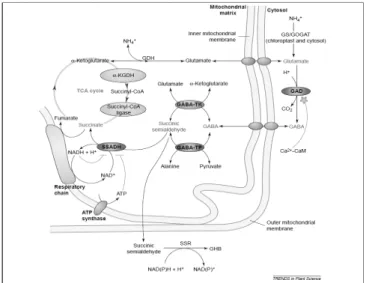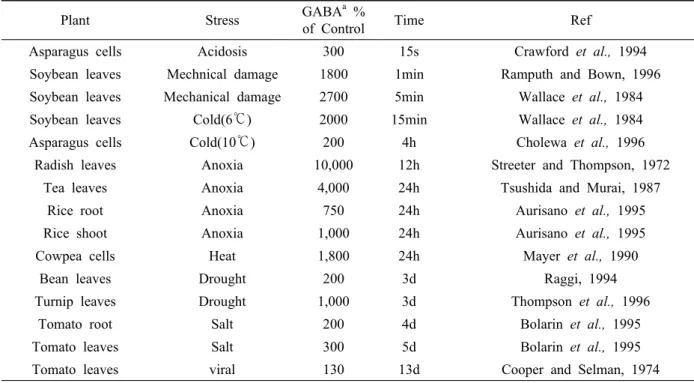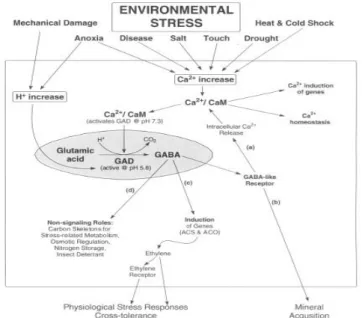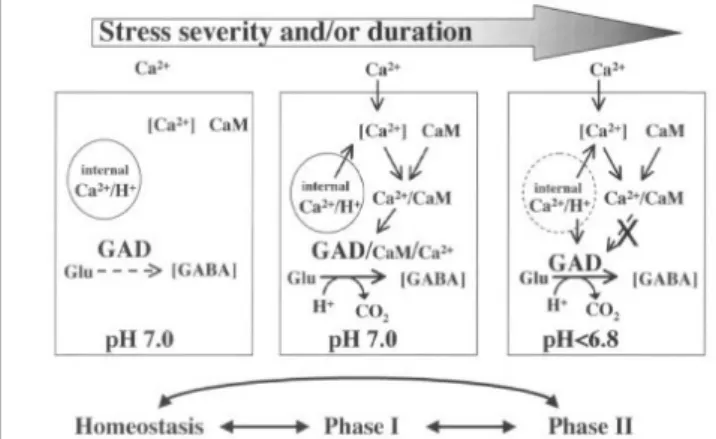γ-Aminobutyric Acid Metabolism in Plant under Environment Stressses
Tae-ho Ham, Sang-ho Chu, Sang Jun Han, and Su-Noh Ryu
†Agricultural Science, Korea National Open Univerisity, Seoul 110-500, Republic of Korea
144
†
Corresponding author: (Phone) +82-2-3668-4631 (E-mail) ryusn@knou.ac.kr
<Received 7 March, 2012; Revised 25 May, 2012; Accepted 5 June, 2012>
ABSTRACT γ-Aminobutyric acid (GABA) is a non-protein amino acid that is widely distributed in plant and animal kingdom. GABA is found in tissues of the central nervous system (CNS) in animals. GABA functions as a the major inhibitory neurotransmitter in the CNS by acting through the GABA receptors. Clinical studies have revealed the relationship between an increased intake of GABA or analogues with several health benefits, including lowering of blood pressure in mildly hypertensive animals and humans. Furthermore, GABA would also has an inhibitory effect on cancer cell proliferation, stimulates cancer cell apoptosis and plays a role in alcohol-associated diseases and schizophrenia. In plants, interest in the GABA emerged mainly from experimental observations that GABA is largely and rapidly produced in large amounts in response to biotic and abiotic stresses. In this study, we speculated the properties and metabolism of GABA in plant and functions in relation to the responses to environmental stresses.
Keywords : GABA, GABA accumulation, GABA metabolism
GABA , a four-carbon non-protein amino acid, is a major component of the free amino acid pool and widely distribute in prokaryotic and eukaryotic organisms. GABA has an amino group on the γ-carbon rather than on the α-carbon, and exists in an unbound form. It is highly soluble in water; structurally it is a flexible molecule that can assume several conformations in solution, including a cyclic structure that is similar to proline.
GABA is zwitterionic(carries both a positive and negative charge) at physiological pH values(Deborah, et al., 2004). In plant, GABA has been treated merely as a metabolite for decades, but the recent evidence points towards a new possible role of GABA as a signal molecule in response to various stress. The interest in GABA shifted to animals when it was revealed that GABA occurs at high levels in the brain, playing a important role in neurotransmission. Clinical studies have related increased
intake of GABA or analogues to several health benefits, including regulation of blood pressure and heart rate, and alleviation of pain and anxiety(Mody et al., 1994). GABA is implicated in a number of neurological disorders including epilepsy, depression, anxiety, Alzheimer’s disease, Parkinson’s disease, schizophrenia and Huntington’s chorea(Deborah, et al., 2004). Furthermore, GABA would also have an inhibitory effect on cancer cell proliferation, stimulate cancer cell apoptosis(Oh, & Oh, 2004), and play a role in alcohol associated diseases and schizopherenia(Caputo, Vignoli, Maremmani, Bernardi, & Zoli, 2009; Oh & Oh 2003).
Recent studies show that GABA is also a strong secretagogue of insulin from the pancreas and effectively prevents diabetes (Adeghate & Ponery, 2002; Hagiwara et al.,2004).
Nowadays, there is a growing interest in natural, minimally processed, nutritional and healthy foods. A plant-based diet, focussing mainly on whole grains, has become one of the most important guidelines for lowering the risk of chronic human diseases(Lawrence & Machlin, 1995). Public interest in nutraceutical foods has led to investigations by biochemical technology to enhance nutritious compositions in cereals and fermentation food.
Although, enough amount of GABA is secreted naturally, there are various obstracles e.g. excess ingestion of estrogen, salicylate and food additives, low-protein diet, deficiency of zinc and vitamin B. Inspite of the supplement quantity of GABA is 500-3000 mg/day, the amount of GABA in cereals is 1-4 mg/100 g in rice, 4-8 mg/100 g in brown rice and 10-100 mg/g in germinated brown rice(BioWave, 2007). To increase amount of GABA in plant, various methods has been applied..
It was discovered in plants more than half a centrury ago (Steward, 1949) and the pathway, called GABA shunt, was first reported in potato(Solanum tuberosum) tuber(Dent et al., 1947). The pathway starts with the decarboxylation of glutamate by gultamate decarboxylase(GAD) to produce GABA and CO
2in the cytosol. GABA is then presumably transported to the
Fig. 1. The γ-aminobutyric aicd(GABA) shunt metabolic pathway and its regulation in plants. The glutamine-sysnthetase/
glutamate-synthase(GS/GOGAT) cycle is the principal nitrogen assimilation pathway into glutamate and amino acids in plants. The glutamate dehydrogenase(GDH) is thought to function primarily in glutamate catabolism but can also function in the opposite direction. The GABA shunt is composed of three enzymes (purple). Glutamate decarboxylase (GAD) is a cytosolic enzyme regulated(green) by the Ca
2+/calmodulin(CaM) complex, which catalyses the irreversibl decarboxylation of glutamate to produce GABA. GABA is transported into the mitochondria, where it is converted into succinic semialdehyde by GABA transaminases using either α-ketoglutarate(by GABA-TK) or pyruvate(by GABA-TP) as amino acid acceptors.
Succinic semialdehyde is then reduced by succinic semialdehyde dehydrogenase(SSADH) to form succinate, which enters the tricarboxylic acid(TCA) cycle. Both ATP and NADH can inhibit the activity of the SSADH enzyme(green).
The succinyl-CoA ligase and the α-ketoglutarate dehydrogenase (α-KGDH) are two enzyme(pink) of the TCA cycle bypassed by the GABA shunt and sensitive to oxidative stress. Succinic semialdehyde can instead be reduced to γ-hydroxybutyric acid(GHB) via a succinic semialdehyde reductase(SSR) localized in the cytosol in animal cells and possibly in plants as well. In mammals, GHB is thought to be a neurotransmitter, whereas its role in plants in unkwon(Ref from Fig 1. Nicolas Bouche and Hillel Fromm, 2004).
mitochondria by an as yet unidentified GABA transporter, where it is converted to succinic semialdehyde(SSA). The presence of GAD activity and GABA in plants was first detected at least half a century ago(Satyanarayan and Nair, 1990; Bouche and Fromm, 2004). The pathway is composed of the cytosolic enzyme GAD and the mitochondrial enzymes GABA transaminase
(GABA-T) and succinic semialdehyde dehydrogenase(SSADH).
The regulation of this conserved metabolic pathway seems to have particular characteristics in plants.
In response to environmental stresses, GABA production often increases so much that cellular levels of this non-protein amino acid exceed that of amino acid involved in protein synthesis(Shelp et al., 1999; Kinnersley, 2000). This situation also has been reported in drought-stressed cotton(Hanower and Brzozowsak, 1975), heat-stressed cowpea cells(Mayer et al., 1990), and soybeans subjected to cold stress and mechanical damage(Wallace et al., 1984).
In 1990s reviews have opinions that functions of GABA shunt associated with pH regulation, N storage, plant development, plant defense, and a role in carbon metabolism(Bown and Shelp, 1997; Satya Narayan and Nair, 1990). A couple of year later, it was suggested that GABA could function as an osmolyte and mitigate water stress(Shelp et al., 1999)
Metabolism of GABA
As mentioned above, GABA metabolism can described by GABA shunt, simply. The first step of this shunt is the direct and irreversible α-decarboxylation of glutamate by glutamate decarboxylas(GAD). GAD is specific for L-glutamate, pyridoxal 5’-phosphate-dependent, inhibited by reagents known to react with sulfhydryl groups, possesses a calmodulin-binding domain.
In E. coli GAD activity is stimulated by low pH with maximal activity at 3.8. A function of GAD in E. coli appears to be the control of cellular pH. For nearly 20 years, plant GADs were thought to function by reducing cellular acidosis in a manner similar to bacterial GADs(Reggiani et al., 1988: Satya Narayan and Nair, 1990: Snedden et al., 1992). This hypothesis was based on observations that: (1) all plant GADs have maximal activity in the acidic range, at approximately pH 5.8; (2) elevated GAD activity has been identified in tissues with low cytoplasmic pH; and (3) the synthesis of GABA consumes a proton and raises pH. exhibits a sharp acidic pH optimum of~5.8, and 12% of maximal activity at pH 7.0.
There are two independent investigation to support the proposal that stress-induced GAD synthesis can contribute to pH regulation(Tsushida and Murai, 1987; Reggiani et al., 1988;
Snedden et al., 1992). That investigations monitored changes
in cytosolic pH and rates of GABA accumulation. A fluorescent
pH probe and an enzymatic assay for GABA were employed
Table 1. Stress-Related Kinetics of GABA Accumulation in Plants
Plant Stress GABA
a%
of Control Time Ref
Asparagus cells Acidosis 300 15s Crawford et al., 1994
Soybean leaves Mechnical damage 1800 1min Ramputh and Bown, 1996
Soybean leaves Mechanical damage 2700 5min Wallace et al., 1984
Soybean leaves Cold(6℃) 2000 15min Wallace et al., 1984
Asparagus cells Cold(10℃) 200 4h Cholewa et al., 1996
Radish leaves Anoxia 10,000 12h Streeter and Thompson, 1972
Tea leaves Anoxia 4,000 24h Tsushida and Murai, 1987
Rice root Anoxia 750 24h Aurisano et al., 1995
Rice shoot Anoxia 1,000 24h Aurisano et al., 1995
Cowpea cells Heat 1,800 24h Mayer et al., 1990
Bean leaves Drought 200 3d Raggi, 1994
Turnip leaves Drought 1,000 3d Thompson et al., 1996
Tomato root Salt 200 4d Bolarin et al., 1995
Tomato leaves Salt 300 5d Bolarin et al., 1995
Tomato leaves viral 130 13d Cooper and Selman, 1974
a



